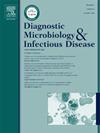与ELISA相比,CLIA免疫分析法可作为检测Sars-Cov-2抗原的一种替代方法
IF 2.1
4区 医学
Q3 INFECTIOUS DISEASES
Diagnostic microbiology and infectious disease
Pub Date : 2025-04-03
DOI:10.1016/j.diagmicrobio.2025.116828
引用次数: 0
摘要
在过去几年中,covid -19在人类中造成了中度严重感染,导致7.59亿确诊病例。这种情况突出表明,迫切需要开发准确的诊断测试来监测传染病,并采用诸如CLIA等替代方法,在诊断平台上实现低检测水平的蛋白质。目的建立ELISA和CLIA内部免疫分析方法诊断COVID-19。方法用拭子采集200例鼻咽标本,置PBS管中,加入3ml PBS。每个样品中取1 mL用于qRT-PCR, CT和lt样品均为阳性;38. 剩余体积用于内部夹心免疫测定ELISA和CLIA。结果CLIA能在N蛋白浓度大于16 ng/mL的样品中检出活动性疾病,灵敏度为90%,特异度为94.5%,ROC曲线下面积(AUROC)为0.943 (95% CI: 0.909 ~ 0.977)。ELISA检测结果显示AUROC = 0.709 (95% CI: 0.639 ~ 0.778),敏感性54.4%,特异性87.2%。结论本研究的CLIA结果优于传统的ELISA,是监测疾病分期进展,包括诊断活动性COVID-19感染的合适平台。本文章由计算机程序翻译,如有差异,请以英文原文为准。
CLIA immunoassay as an alternative and accurate method to detect Sars-Cov-2 antigen compared to ELISA
Background
COVID-19 has caused moderately severe infections in humans over the past few years, leading to >759 million confirmed cases. This situation highlights an urgent need to develop accurate diagnostic tests to monitor infectious disease and to adopt alternative methods such as CLIA to achieve low detection levels of proteins on diagnostic platforms.
Objectives
Develop in-house immunoassay for ELISA and CLIA to diagnose COVID-19.
Methods
200 nasopharyngeal samples were collected using swabs, placed in tubes with 3 mL of PBS. 1 mL from each sample was used to perform qRT-PCR and was considered positive in samples with CT < 38. The remaining volume was used for in-house sandwich immunoassay ELISA and CLIA.
Results
The results showed that CLIA was able to detect active disease in samples containing N protein concentrations greater than 16 ng/mL, with a sensitivity of 90 % and specificity of 94.5 %, and an area under the ROC curve (AUROC) of 0.943 (95 % CI: 0.909–0.977). ELISA showed an AUROC = 0.709 (95 % CI: 0.639–0.778), with a sensitivity of 54.4 % and specificity of 87.2 %.
Conclusions
The CLIA results in this study outperformed the traditional ELISA and proved to be a suitable platform for monitoring the progression of disease stages, including the diagnosis of active COVID-19 infection.
求助全文
通过发布文献求助,成功后即可免费获取论文全文。
去求助
来源期刊
CiteScore
5.30
自引率
3.40%
发文量
149
审稿时长
56 days
期刊介绍:
Diagnostic Microbiology and Infectious Disease keeps you informed of the latest developments in clinical microbiology and the diagnosis and treatment of infectious diseases. Packed with rigorously peer-reviewed articles and studies in bacteriology, immunology, immunoserology, infectious diseases, mycology, parasitology, and virology, the journal examines new procedures, unusual cases, controversial issues, and important new literature. Diagnostic Microbiology and Infectious Disease distinguished independent editorial board, consisting of experts from many medical specialties, ensures you extensive and authoritative coverage.

 求助内容:
求助内容: 应助结果提醒方式:
应助结果提醒方式:


